Power, Sound, R/C
:
Battery
Battery Power / Radio Control Part 2
Mar 3, 2004


By Randy Mower |
Author
Bio
There are literally dozens of types of batteries from Alkaline to Zinc Air. Not all types are rechargeable, and not all have practical applications in garden railroading.
|
Types of Batteries There are literally dozens of types of batteries from Alkaline to Zinc Air. Not all types are rechargeable, and not all have practical applications in garden railroading. Lithium Ion and Lithium Polymer - These batteries are rechargeable and can be re-used 500-1000 times, however, these types of batteries require special charging circuitry to avoid overcharging. So far their acceptance for garden railroading has been limited and for the purposes of this article we won't be going into detail on their use. However, there are four common types of batteries used in garden railroading: 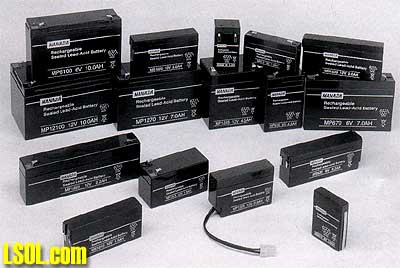 Lead Acid/Gel Cell Sealed Lead Acid - Lead acid batteries are like those commonly used to start your car. It consists of lead plates immersed in an acid based electrolyte solution. The electrolyte solution stores the electrical charge, which is then dispersed through the plates as an electrical current. Gel cell batteries are similar only the electrolyte is a gel instead of liquid. These batteries can hold a large charge but they can get large and heavy to do it. The other characteristic of lead acid batteries is that they cannot be quickly recharged, this type of battery requires the use of a "trickle charger" which charges the battery slowly with a low current.
In garden railroading applications it is possible to use lead acid batteries but because of their size it is often not possible to have on-board batteries in the engine. To use this type of battery often requires the batteries to be hauled in a trailing car or a dummy (diesel or electric) locomotive. This type of battery must have a maintenance charger to keep it charged as if it left in a discharged state for too long it will damage the battery. A lead acid battery will lose about 3% of its charge a month if there is no trickle charger maintaining it. Lead acid batteries can be recharged up to 2,000 times or more. This type of battery will lose voltage as it nears discharge (over 50%), which will result in the trains running slower and slower as it discharges. 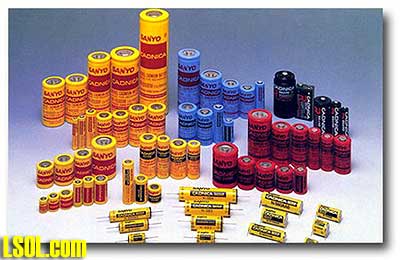 NiCad - NiCads (Nickel Cadmium) are one of the most proven and widely used types of rechargeable batteries. These batteries have a moderate storage capacity that is usually more than sufficient for our garden railroad applications. These batteries can handle a high discharge rate and can conversely be recharged quickly too. Chargers are available that can trickle charge, fast charge or both. Whenever possible it is best to trickle charge to extend the battery's life. Another consideration with NiCad batteries something called "memory effect" that can temporarily lessen the capacity of the battery. Memory effect is caused by operating a NiCad in successive cycles to less than full discharge and recharging it again. In other words if your batteries would normally run your trains for 3 hours and you only run them for a half an hour then recharge them again and again the battery will loose part of its capacity. This phenomenon can be easily avoided by running the batteries down before you recharge them again. This type of battery should be in a discharged state if it is going to be stored for a long period of time. A NiCad battery will lose about 15% of its charge a month if there is no trickle charger maintaining it. NiCad batteries can be recharged up to 2,000 times or more. This type of battery does not loose much voltage (less than 25%) as it nears discharge, which will result in the trains running at near normal speed until just before the batteries go dead.
NiMh - Nickel Metal Hydrate batteries are a fairly new technology which we can largely thank cell phones for. These are similar to NiCad batteries just different materials are used. These batteries have a higher ampere-hour capacity then NiCads (10-25% more for the same size) of the same size and do not have problems with "memory" like NiCads can. The problem with NiMh batteries is you need to be careful to match the charger to the batteries otherwise then can overheat when charging to the point where they can melt plastic or even combust. Dry cell & Alkaline - These are the batteries you buy for your kid's Game Boy, your TV remote, and your calculator. Dry cells are the old-fashioned carbon/zinc battery. Modern alkaline batteries deliver 50 to 100% more capacity than their dry cell predecessors. These types of battery are not rechargeable and when they are discharged all you can do is discard them. While it's use in powering garden railway trains is limited, sometimes they can be used for small vehicles like stompers, handcars, and speeders. 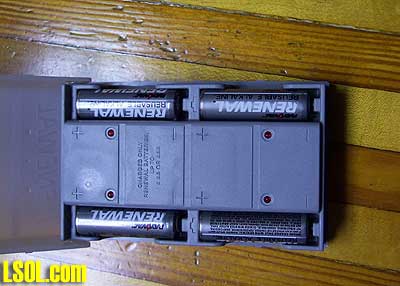 Renewals - These are a special type of alkaline battery that can be recharged. While their use in garden railroading is limited. Their application can be the same as those for dry cell batteries. In addition, they can be used in transmitters that use AA batteries such as BEC transmitters or the Aristocraft train engineer transmitter. Amp Hour Ratings - Amp Hour ratings is a measure of a battery's capacity. When dealing with the size batteries we are using the measure used is Milliamp Hour Ratings (mAh). A milliamp is 1/1000 of an ampere. So a 2,000 mAh battery can deliver 2,000 milliamps of current for one hour. If we draw less than 2,000 mA the battery will run longer. So in theory, if we draw 500 milliamps the battery will run 3-4 hours. Voltages - Lead Acid batteries are available in common voltages of 6 or 12 volts. NiCad and NiMh batteries are 1.2 volts per battery, which are connected together in packs to reach a desired voltage. The most common pre-made packs are 6 batteries, which will make up 7.2V or 8 batteries which will make up 9.6V. The packs used by R/C car enthusiasts of 7.2 volts are handy because two of these together in series make 14.4 volts which is ideal for many garden railroad applications. 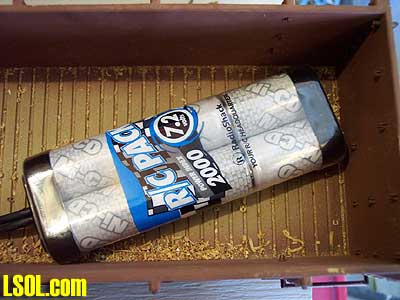 Custom Packs/Types of Batteries - Round batteries come with either a button end or a tab end. The button end is just like a standard dry cell or alkaline battery. Tab ends have a piece of flat tin on the ends of the battery that let you solder the batteries in series to make up custom battery packs. You can make up custom sized packs or position the batteries to fit a specific area like a firebox, boiler, or tender. 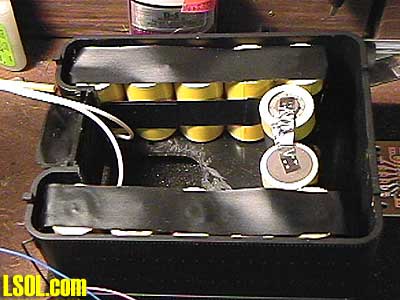
Onboard, Trailing Car or Both? - One of the most challenging aspects of using battery power radio control is trying to figure out where to put the batteries. There are two options for battery placement: Onboard Batteries - If possible, onboard batteries give you the most flexibility in running your trains, and you can run a light engine if you want to. The hard part of course if figuring out where to put the batteries in smaller engines. Most diesels and larger steam engines with tenders are not too difficult to find a place for the batteries, but smaller steamers and engines with no tenders like a Porter or small tenders like a Shay or Climax doesn't have a lot of room and will often require custom packs of loose batteries to fit into the available space. An engine with a tender is usually an easy conversion. In this case I used two R/C battery packs to power and radio controlled a Bachmann 10th anniversary 10-wheeler. 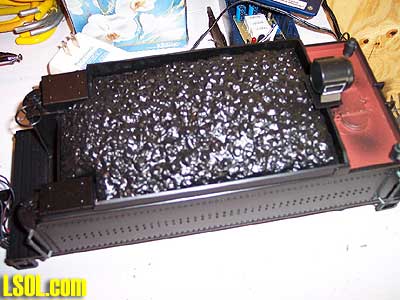 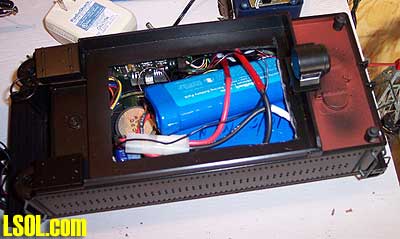 Battery Trailing Cars - The other option for battery placement is to use a battery-trailing car to haul the batteries behind the engine. A power feed wire is run between the car and the engine to transfer electricity to the power unit. If you use lead-acid batteries you will probably have to use a battery-trailing car unless you have a very large engine with a lot of internal space (such as a large cab diesel like the PA-1 or E-8). Aristocraft's newer engines have a power connecting wire built into the engine to make it easy to supply power from their battery-trailing car. I made a battery-trailing car using a Bachmann wood side gondola. I made a foam insert with sawdust glued on top to simulate a loaded car. 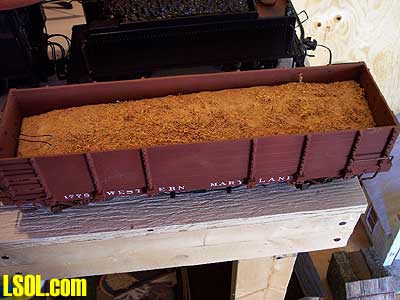 I made the car up to carry two R/C battery packs to provide 14.4 volts. While all of my engines have onboard batteries, I wanted to have a backup power supply for my Shay which does not have removable batteries. I wired my Shay with an auxiliary power plug so that when the onboard batteries were discharged I could keep running on auxiliary power. 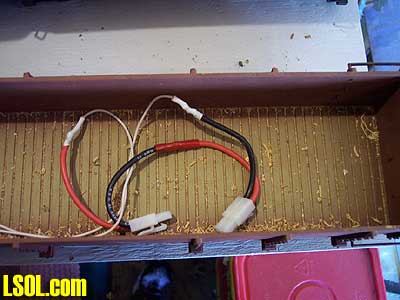 The car was wired up with female plugs to connect the batteries and connected in series. A small power plug was installed on the car's end sill. 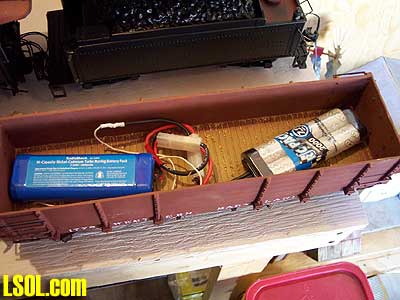 After the batteries are plugged in and laid on the floor of the car, the foam load is placed on top to cover them up and we can run our Shay for another 3-4 hours.
Sources for Batteries - If you do a search for batteries on the internet you will find dozens if not hundreds of sources for batteries. One internet source I have personally used with no problems is www.batterystation.com. You also always go to your local electronics supply, battery supply store, or Radio Shack. If you decide to go the lead-acid battery route Aristocraft offers a complete system with a set of three 6-volt batteries connected in series to make 18-volts, a charger for the batteries, and a battery trailing car to carry them. In fact you can buy them from LSOL. Reportedly Aristocraft will be coming out with a Ni-Cad or NiMh system as well. Chargers - There are various chargers available which need to be matched to the type of battery that is being used. For example you do not want to force charge a lead acid battery as overcharging can "cook" the battery and ruin it. Most of the same suppliers for batteries will also offer chargers as well. If you are using the pre-formed Ni-Cad or Ni-Mh R/C racing packs you can buy a standard charger that will trickle charge, rapid charge or both. 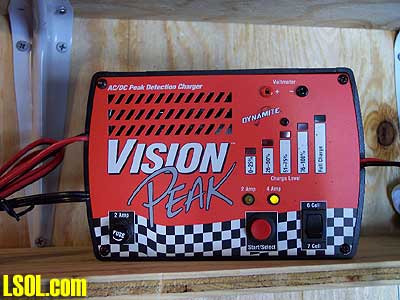 If you are using custom packs, or sealed lead-acid batteries you will want to purchase a charger that will match the batteries you are using. 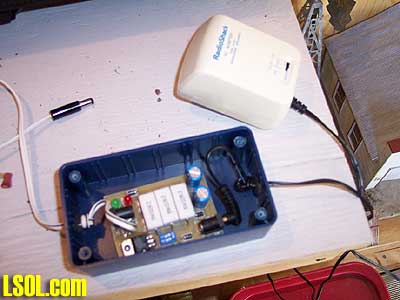 When converting my Shay to battery power, I made up a custom pack that I soldered together to fit in the tender, I had to get a charger that matched the voltage and amp-hour rating of my custom pack. I purchased a charger control unit made by RCS (Remote Control Systems) which I use to charge it's custom battery pack. There are small dip switches on the control unit which are set to match the battery pack it is regulating the charge for. 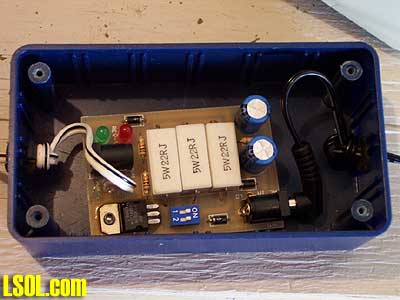 Next Time: Battery Controls - Next time we will look at some different options for controlling the engine with radio control units. Top of Page
|



